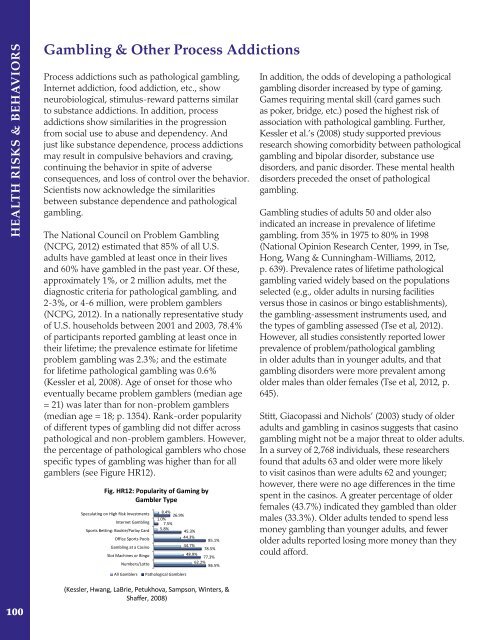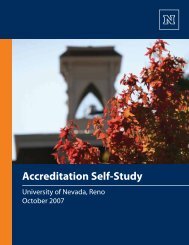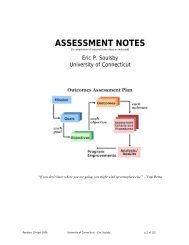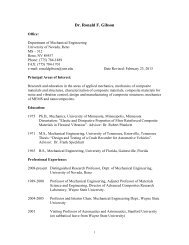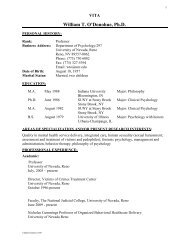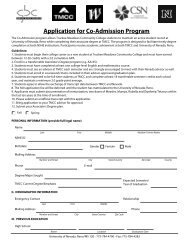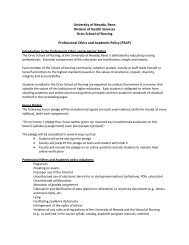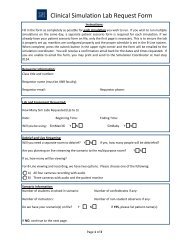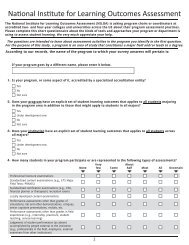S ongquan D eng / Shutterstock .com - University of Nevada School ...
S ongquan D eng / Shutterstock .com - University of Nevada School ...
S ongquan D eng / Shutterstock .com - University of Nevada School ...
You also want an ePaper? Increase the reach of your titles
YUMPU automatically turns print PDFs into web optimized ePapers that Google loves.
Health Risks & Behaviors<br />
Gambling & Other Process Addictions<br />
Process addictions such as pathological gambling,<br />
Internet addiction, food addiction, etc., show<br />
neurobiological, stimulus-reward patterns similar<br />
to substance addictions. In addition, process<br />
addictions show similarities in the progression<br />
from social use to abuse and dependency. And<br />
just like substance dependence, process addictions<br />
may result in <strong>com</strong>pulsive behaviors and craving,<br />
continuing the behavior in spite <strong>of</strong> adverse<br />
consequences, and loss <strong>of</strong> control over the behavior.<br />
Scientists now acknowledge the similarities<br />
between substance dependence and pathological<br />
gambling.<br />
The National Council on Problem Gambling<br />
(NCPG, 2012) estimated that 85% <strong>of</strong> all U.S.<br />
adults have gambled at least once in their lives<br />
and 60% have gambled in the past year. Of these,<br />
approximately 1%, or 2 million adults, met the<br />
diagnostic criteria for pathological gambling, and<br />
2-3%, or 4-6 million, were problem gamblers<br />
(NCPG, 2012). In a nationally representative study<br />
<strong>of</strong> U.S. households between 2001 and 2003, 78.4%<br />
<strong>of</strong> participants reported gambling at least once in<br />
their lifetime; the prevalence estimate for lifetime<br />
problem gambling was 2.3%; and the estimate<br />
for lifetime pathological gambling was 0.6%<br />
(Kessler et al, 2008). Age <strong>of</strong> onset for those who<br />
eventually became problem gamblers (median age<br />
= 21) was later than for non-problem gamblers<br />
(median age = 18; p. 1354). Rank-order popularity<br />
<strong>of</strong> different types <strong>of</strong> gambling did not differ across<br />
pathological and non-problem gamblers. However,<br />
the percentage <strong>of</strong> pathological gamblers who chose<br />
specific types <strong>of</strong> gambling was higher than for all<br />
gamblers (see Figure HR12).<br />
Fig. HR12: Popularity <strong>of</strong> Gaming by<br />
Gambler Type<br />
Speculating on High Risk Investments<br />
Internet Gambling<br />
Sports Betting: Bookie/Parlay Card<br />
Office Sports Pools<br />
Gambling at a Casino<br />
Slot Machines or Bingo<br />
Numbers/Lotto<br />
All Gamblers<br />
8.4%<br />
26.9%<br />
1.0%<br />
7.5%<br />
5.8%<br />
45.3%<br />
44.3%<br />
85.1%<br />
44.7%<br />
78.5%<br />
48.9%<br />
77.3%<br />
62.2%<br />
86.5%<br />
Pathological Gamblers<br />
In addition, the odds <strong>of</strong> developing a pathological<br />
gambling disorder increased by type <strong>of</strong> gaming.<br />
Games requiring mental skill (card games such<br />
as poker, bridge, etc.) posed the highest risk <strong>of</strong><br />
association with pathological gambling. Further,<br />
Kessler et al.’s (2008) study supported previous<br />
research showing <strong>com</strong>orbidity between pathological<br />
gambling and bipolar disorder, substance use<br />
disorders, and panic disorder. These mental health<br />
disorders preceded the onset <strong>of</strong> pathological<br />
gambling.<br />
Gambling studies <strong>of</strong> adults 50 and older also<br />
indicated an increase in prevalence <strong>of</strong> lifetime<br />
gambling, from 35% in 1975 to 80% in 1998<br />
(National Opinion Research Center, 1999, in Tse,<br />
Hong, Wang & Cunningham-Williams, 2012,<br />
p. 639). Prevalence rates <strong>of</strong> lifetime pathological<br />
gambling varied widely based on the populations<br />
selected (e.g., older adults in nursing facilities<br />
versus those in casinos or bingo establishments),<br />
the gambling-assessment instruments used, and<br />
the types <strong>of</strong> gambling assessed (Tse et al, 2012).<br />
However, all studies consistently reported lower<br />
prevalence <strong>of</strong> problem/pathological gambling<br />
in older adults than in younger adults, and that<br />
gambling disorders were more prevalent among<br />
older males than older females (Tse et al, 2012, p.<br />
645).<br />
Stitt, Giacopassi and Nichols’ (2003) study <strong>of</strong> older<br />
adults and gambling in casinos suggests that casino<br />
gambling might not be a major threat to older adults.<br />
In a survey <strong>of</strong> 2,768 individuals, these researchers<br />
found that adults 63 and older were more likely<br />
to visit casinos than were adults 62 and younger;<br />
however, there were no age differences in the time<br />
spent in the casinos. A greater percentage <strong>of</strong> older<br />
females (43.7%) indicated they gambled than older<br />
males (33.3%). Older adults tended to spend less<br />
money gambling than younger adults, and fewer<br />
older adults reported losing more money than they<br />
could afford.<br />
100<br />
(Kessler, Hwang, LaBrie, Petukhova, Sampson, Winters, &<br />
Shaffer, 2008)


